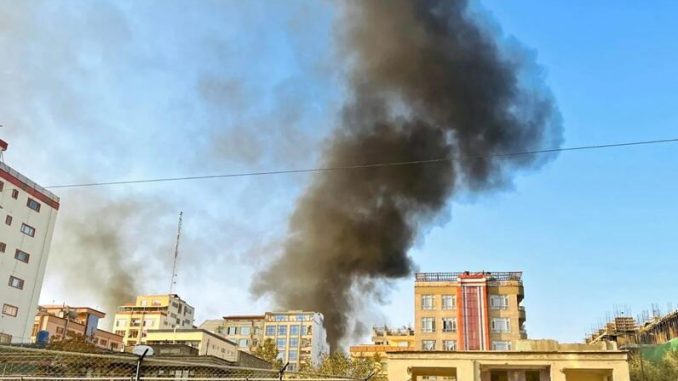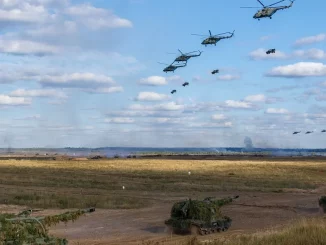
Published October 15, 2025
The uneasy peace between Pakistan and Afghanistan has shattered as fierce border clashes and drone strikes signal the worst fighting between the two neighbors in years. The confrontation, which erupted earlier this week, has already claimed dozens of lives and prompted fears of a broader regional conflict.
According to multiple reports, including ZeroHedge and Radio Free Europe/Radio Liberty (RFE/RL), Pakistan carried out air and drone strikes inside Afghan territory, including Kabul and Paktika province, targeting what Islamabad described as hideouts of the Tehrik-e-Taliban Pakistan (TTP) — a militant group responsible for numerous attacks inside Pakistan.
Taliban Condemns Attacks
The Taliban government in Kabul swiftly condemned the strikes, calling them a “violation of Afghanistan’s sovereignty” and warning Islamabad against further aggression. Taliban officials claimed several civilians were killed in the strikes and vowed to respond if Pakistan continues its cross-border operations.
“The Islamic Emirate of Afghanistan cannot tolerate attacks on its soil,” a Taliban spokesperson said in a televised address, accusing Pakistan of destabilizing the region under the pretext of counterterrorism.
The Border Turns into a Warzone
The deadly exchange has spread across the Durand Line, the disputed 2,600-kilometer border dividing the two countries. Skirmishes have been reported near the Torkham and Chaman crossings — two of the busiest trade routes linking Central and South Asia. Both crossings have been closed, halting the movement of goods and people and worsening the economic strain on border communities.
Local witnesses described intense shelling and gunfire, with entire families fleeing villages caught in the crossfire. Reports indicate that thousands of residents on both sides have been displaced, while hospitals in border towns struggle to treat the wounded.
TTP at the Heart of the Conflict
At the core of the escalating tensions is the TTP, a Pakistan-based militant group ideologically aligned with the Afghan Taliban but operating independently. Islamabad has long accused Kabul of providing safe haven to TTP fighters, who have carried out bombings, ambushes, and assassinations inside Pakistan — particularly targeting security forces and police.
Since the Taliban regained control of Afghanistan in 2021, Pakistan hoped the new regime would curb TTP operations. Instead, attacks in Pakistan have increased sharply. The TTP’s boldness has frustrated Islamabad, which now sees Kabul’s reluctance to act as tacit support for the militants.
Afghan officials deny the accusation, insisting that the Taliban do not allow any group to use Afghan soil to attack another country. “The problem lies within Pakistan’s own territory,” a senior Taliban commander told RFE/RL. “They are trying to export their failures to Afghanistan.”
Humanitarian Impact and Global Concern
Beyond the military confrontation, the situation has taken a grave humanitarian turn. Civilians living near the frontier have fled their homes, while aid groups warn of worsening food shortages as trade routes remain closed.
The United Nations expressed concern about the “alarming escalation of violence” and urged both sides to exercise restraint. International observers fear that the renewed hostilities could unravel the fragile stability Afghanistan has maintained since the U.S. withdrawal in 2021.
Meanwhile, Pakistani media report that the government is reviewing diplomatic and military options to “protect national security.” Analysts say Islamabad is under domestic pressure to show strength, especially after recent TTP attacks killed dozens of Pakistani soldiers.
Fragile Relations and Regional Ripples
Pakistan and Afghanistan share deep cultural and historical ties but have often been divided by mutual suspicion. The Durand Line, drawn by British colonial authorities in 1893, remains a point of contention — with the Taliban refusing to recognize it as an official border.
The current crisis further exposes the fragile nature of their relationship. What was once seen as an alliance between Pakistan and the Taliban following the U.S. withdrawal from Kabul has now evolved into open hostility.
The violence also has potential ripple effects beyond the two countries. Observers warn that the instability could disrupt trade routes linking China’s Belt and Road Initiative in Pakistan’s Gwadar port to Central Asia, while neighboring countries like Iran and India watch closely for any strategic shift in alliances.
For now, both governments have signaled a desire to avoid full-scale war — but with border tensions intensifying, drone strikes expanding, and civilians caught in the middle, the situation remains one of the most volatile flashpoints in South Asia today.
 Implications
Implications
1. Regional Security Threat
The clashes mark a serious deterioration in relations between Islamabad and Kabul, threatening the fragile security balance in South Asia. Pakistan’s drone and air strikes in Kabul and Paktika could provoke a full-scale retaliation by the Taliban, potentially sparking a prolonged border war that destabilizes the entire region.
2. Resurgence of Militant Networks
The renewed violence could embolden the Tehrik-e-Taliban Pakistan (TTP) and other militant groups operating in the tribal areas. With Kabul accused of harboring these fighters and denying Pakistan’s claims, militant sanctuaries may expand — making it harder for either government to control extremist factions.
3. Economic and Humanitarian Fallout
Both nations are already grappling with economic crises.
-
Pakistan faces high inflation, currency devaluation, and IMF-imposed austerity.
-
Afghanistan remains heavily dependent on aid and smuggling routes across the border.
Continued fighting could close trade routes, disrupt supply chains, and cause severe shortages of food and fuel, worsening poverty and displacement.
4. Erosion of Taliban’s International Standing
The Taliban, already isolated diplomatically, risk losing even limited recognition if they are seen as supporting terrorist groups or violating cross-border sovereignty. Escalation could push away potential partners like China, Russia, and Gulf states, who prefer regional stability for investment and infrastructure projects.
5. Pakistan’s Strategic Dilemma
Islamabad expected a cooperative Taliban regime after the 2021 U.S. withdrawal, but the opposite has occurred. The Afghan Taliban’s defiance and growing nationalist stance show that Pakistan’s leverage is weakening. Islamabad’s attacks on Afghan soil could also damage its image internationally, portraying it as an aggressor rather than a victim of terrorism.
6. Shift in Regional Alliances
If tensions persist, Afghanistan could strengthen ties with India — Pakistan’s long-time rival — and possibly seek limited backing from Iran. This could realign traditional power blocs in South Asia, giving India more influence in the Afghan political landscape while isolating Pakistan further.
7. Humanitarian Crisis Along the Border
The closure of key crossings like Torkham and Chaman will hurt civilians most. Thousands of families depend on daily cross-border trade for food and medicine. The United Nations has already expressed concern over reports of civilian casualties and mass displacement, warning that the situation could spiral into another refugee crisis.
8. Potential for International Involvement
If the violence continues, major powers — including China, the U.S., and Russia — may be forced to intervene diplomatically to prevent another regional war. China’s Belt and Road investments in Pakistan and Central Asia could be threatened, adding economic urgency to global mediation efforts.
 Overall Takeaway:
Overall Takeaway:
The deadly escalation between Pakistan and Afghanistan represents more than just another border skirmish — it signals a potential turning point in South Asian geopolitics. Both sides are locked in a dangerous cycle of blame and retaliation, with Pakistan accusing Kabul of harboring terrorists and the Taliban condemning Islamabad’s cross-border strikes as violations of sovereignty.
If the conflict continues unchecked, it could reignite instability across the region, empower militant groups, and deepen humanitarian suffering on both sides of the Durand Line. The fragile peace achieved after the U.S. withdrawal from Afghanistan now hangs by a thread, threatened by political mistrust and competing national interests.
Ultimately, stability will depend on whether Pakistan and the Taliban can reopen channels for negotiation, curb militant activities, and prevent the conflict from spilling into a wider regional war. Without restraint and dialogue, South Asia could once again find itself drawn into a prolonged crisis — one that neither nation, nor the international community, can afford.
SOURCES: ZEROHEDGE – Deadliest-Ever Fighting Between Pakistan & Afghanistan Sees Drone Strikes On Kabul
RADIO FREE EUROPE RADIO LIBERTY – Once Allies, Pakistan And Afghan Taliban Lurch Toward Full-Blown Conflict





Be the first to comment